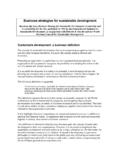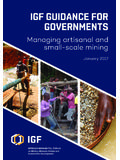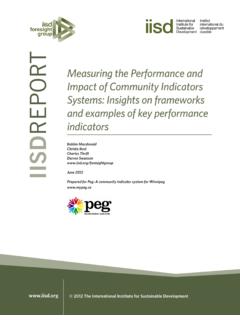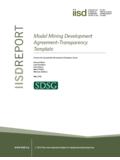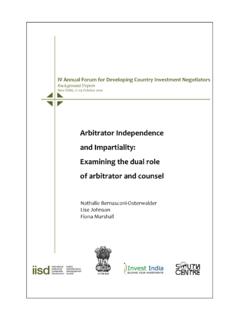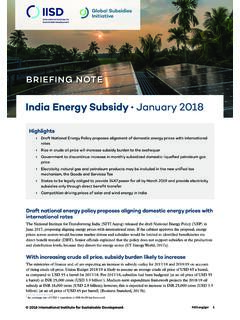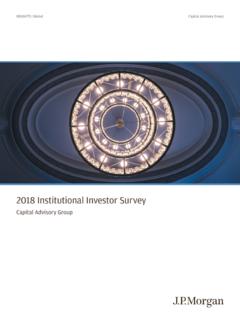Transcription of Currency Risk in Project Finance - IISD
1 DISCUSSION PAPER. Currency Risk in Project Finance Wim Verdouw (IMG Rebel), David Uzsoki and Carlos Dominguez Ordonez August 2015. In developed and developing countries alike, there It then proposes a two-pronged strategy for IFIs is a very large need for infrastructure investment to address the issue of Currency risk, focusing on as existing infrastructure ages, economies improving local capital markets and developing develop and populations grow. According to the local Currency financing solutions. Based on this McKinsey Global Institute, in order to keep up strategy, the paper then analyzes various financial with projected global GDP growth, the world will tools that IFIs can use to stimulate local Currency need to invest an estimated $57 trillion between financing in order to help countries meet their 2015 and 2030 (Dobbs et al.)
2 , 2013). For most development goals while limiting their exposure to countries, relying on state budgets alone will not Currency risk. be sufficient to meet such large investment needs. Public-private partnerships (PPPs), in which 1. Currency risk in Project Finance governments work together with the private sector to develop and Finance infrastructure, can therefore Hard Currency loans can create a Currency risk play an important role. In developing countries, if revenues are in local Currency . For example, a international financing institutions (IFIs), such as power plant in India may be financed in dollars, the International Finance Corporation (IFC), and but if electricity tariffs are in rupees, this creates other multilateral development banks often help an asset-liability Currency mismatch.
3 If the rupee Finance key infrastructure projects, predominantly depreciates against the dollar by 10 per cent, through hard Currency loans. Without the revenues remain unchanged but the liabilities are participation of IFIs, international commercial now 10 per cent higher. One of the key challenges banks would typically be hesitant to participate in in Project Finance in emerging and frontier markets the financing of such projects. However, due to the is to determine who should assume this Currency nature of the international floating exchange rate risk. regime, hard Currency loans create Currency risk, In PPPs, an optimal risk allocation generally means which in turn results in uncertainty and potential that a risk should be allocated to the party that is additional liabilities for the receiving countries.
4 To best positioned to manage or bear that risk, or more avoid this situation, local Currency financing would specifically, the party that can accept the risk at be preferable but may not always be available. the lowest costs. However, regarding Currency risk This paper analyzes the impacts of Currency risk on in these markets, this optimal risk allocation may infrastructure projects in developing markets and not be so straightforward. A typical private sector identifies ways that Currency risk can be managed. developer has no influence over the exchange rate. 2015 International Institute for Sustainable Development 1. Although the central bank has some control over may undermine one of the key advantages of the exchange rate through its monetary policies, the PPPs, which is the relative cost certainty achieved government's effective control of the exchange rate through long-term contracts.
5 Besides the technical may be limited. As a result of the above, unhedged complexity of exchange rate risk and lack of cost Currency risk is largely unmanageable for the certainty, there can also be an important perception private sector and may be beyond the control of issue: if the procuring agency and therefore the government agency in charge of infrastructure ultimately the public directly bears the Currency development, which means that it may not be easily risk and observes how the local Currency payment acceptable for either party. for the same service significantly increases year after year, it may conclude that the Project 's foreign Developers and investors have no control over financiers must be making excessive returns.
6 In the exchange rate and will therefore try to either reality, the foreign financiers may be making a manage the risk (see below for risk management normal risk-adjusted return on their hard Currency strategies) or price the exchange rate risk in their investments and/or loans. rates/tariffs. As Currency risk can also have an upside (or lower downside than expected), it could create a windfall for the developers/investors. From 2. Managing Currency risk the lenders' perspective, beyond receiving interest There are a number of strategies to manage payments on the principal, there is no potential Currency risk. However, it should be recognized for upside.
7 Lenders will therefore typically not upfront that these strategies are typically costly to accept any significant Currency risk and expect one of the parties involved: the Project developer, the developer to ensure that any Currency risk the financiers, or government. When negotiating Project may assume will not affect its debt service. contracts with private sector developers, Given the inherent uncertainties in exchange rate governments (or publicly owned utilities) need risk and the lack of a predetermined logical risk to acknowledge the real cost of hard Currency allocation to either the government or the private financing, which includes both the cost of capital sector, Currency risk can be a difficult and sensitive in hard Currency and the cost of Currency risk that topic in negotiations between the private sector the developer is expected to assume.
8 Text box 1. developer and the government. Furthermore, the contains a variety of Currency risk strategies that uncertainty that Currency risk inherently carries can be used to manage Currency risk. Text Box 1: Currency risk management strategies (Partial) Natural hedge To reduce the asset-liability Currency mismatch that occurs when using foreign Currency financing for local service delivery, a developer may choose to sell a portion or all of the Project 's output to a country with the same Currency as its liabilities. For example, the Nam Theun 2 hydropower Project in Laos is partially financed by Thai banks through Thai baht denominated loans and also exports a significant proportion of its energy production to Thailand (Multilateral Investment Guarantee Agency [MIGA], 2006).
9 As a result, the Thai baht . denominated loans are not exposed to Currency risk. A similar structure has been adopted by Bhutanese hydropower projects that export their production to India, where both debt and the power purchase agreement are in Indian rupees. Local Currency swap Under a Currency swap, two parties agree to exchange principal and/or interest payments of a loan in one Currency for an equivalent loan in another Currency . Such swaps allow lenders/borrowers and investors to hedge (a part of) their loans/investments. However, for some emerging and many frontier markets, Currency swaps are not commercially available.
10 The IFC can provide Currency swaps for a number of these markets. Furthermore, the Currency Exchange Fund (TCX) is a special purpose fund that can provide Currency hedge products for local borrowers in frontier and less liquid emerging markets. IISD DISCUSSION PAPER 2. Currency Risk in Project Finance Text Box 1: Currency risk management strategies (continued). Exchange rate indexed contracts If a Project 's revenues are indexed to the exchange rate, a Currency swap is effectively built in to the contract. As a result, the Currency risk is transferred to the buyer, often a state utility or government entity. While this strategy solves the Currency risk for the developer and financiers, it does not solve the issue for the buyer/.

